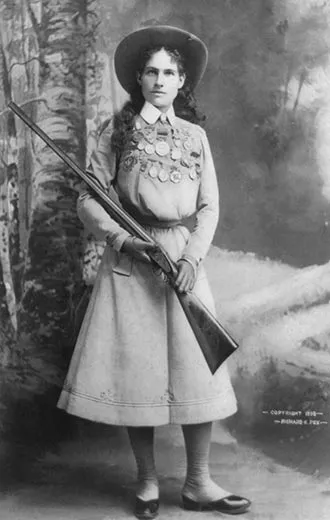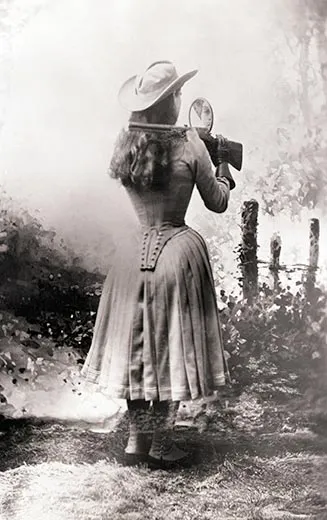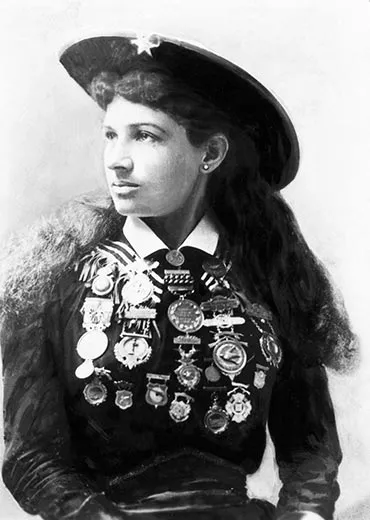How Annie Oakley, “Princess of the West,” Preserved Her Ladylike Reputation
Born in 1860, the famed female sharpshooter skillfully cultivated an image of a daredevil performer with proper Victorian morals
/https://tf-cmsv2-smithsonianmag-media.s3.amazonaws.com/filer/Annie-Oakley-shooting-over-shoulder-631.jpg)
“Famous Woman Crack Shot. . . Steals to Secure Cocaine.” It would have seemed, on August 11, 1903, the day this headline first appeared in two of William Randolph Hearst’s newspapers, that Annie Oakley would be the last woman behind such a despicable act. And yet it was she, the newspapers claimed, who was facing a 45-day sentence in a Chicago prison for literally stealing a man’s breeches to get her fix. This 28-year-old woman, the newspapers claimed, looked to be almost 40, her “striking beauty” entirely gone from her face.
The headlines were laden with fallacies. Having retired from Buffalo Bill Cody’s Wild West Show two years earlier in 1901, Oakley had been leading a quiet existence on the New Jersey shore, far from the scene of the alleged crime. She had never used cocaine; she had never stolen anyone’s trousers. She was actually almost 43 years old.
Newspapers across the country got wind of the story, and soon similar headlines inundated the national media. It surfaced that a burlesque performer named Maude Fontanella, using the name “Any Oakley,” was the true culprit. Oakley demanded that the newspapers retract their stories, but it was too late. The damage to her formerly pristine public image as the “princess of the West” inside the shooting arena and a proper Victorian lady in all other aspects of life—an image Oakley tended painstakingly throughout her career—had been done.
All that was left was to seek retribution. For the next seven years she would sue 55 different newspapers for libel, the largest action of its kind in history. When her last appeal concluded in 1910, seven years after the first libelous newspaper headline appeared, she had won or settled 54 out of 55 suits, winning the then enormous sum of $27,500 in her suit against Hearst’s Chicago newspapers. In spite of all her legal victories, Oakley actually lost money once expenses were accounted for; vindicating her reputation was more important.
Like the many clay pigeons she had shot out of thin air, when it came to cultivating and preserving her own image, Oakley was spot on. “She was one of the first American celebrities who was really branding herself, and she was very shrewd about her own marketing,” says Virginia Scharff, a history professor at the University of New Mexico and Women of the West chair at the Autry National Center in Los Angeles. Which is why, after years of carefully crafting her identity, the libelous newspaper headlines seized Oakley so drastically.
Born Phoebe Ann Moses in Darke County, Ohio, on August 13, 1860, Oakley was not exactly a product of the Wild West. She came from a Quaker family and a childhood marred by poverty and abandonment (her father died when she was 6 and her mother sent Annie to work for an abusive foster family when she could no longer support her). “This is somebody who out of a nightmarish childhood, picks up a gun,” says Scharff.
From the second she began shooting—first to put food on the table and only later as an entertainer—there was no denying Oakley’s knack for the sport. After meeting and marrying Frank Butler, she performed for years in the vaudeville circuit before joining Buffalo Bill’s show in 1885. She quickly became known as a maid of the West, performing stunts like shooting clay pigeons out of the air with a rifle while standing atop a galloping horse.
Of course, to maintain her “ladyhood,” she always wore a skirt—usually one she had sewn herself.
“To present herself as a woman who had developed all the feminine skills that would be expected was very important to her,” says Mary Zeiss Stange, a professor of women’s studies at Skidmore College. “She was aware of the kinds of gender boundaries that she was trespassing.” Along with being a female in a field largely dominated by males, she had become an almost instant celebrity and had acquired wealth, which were essentially unheard of among women of that time.
But her success was predicated upon walking a delicate line between her celebrated talent for shooting and the Victorian social norms that valued ladylike, modest behavior over earning power.
“She had to make a girl that could shoot acceptable to a Victorian public,” says Scharff. “She’s inventing this new identity of the spunky Western girl who’s no threat to men who are good men.”
As a female shooter, Oakley took measures not to be perceived as dangerous; very few (if any) images exist that depict her killing any live animals. It was Oakley’s girlish manner—combined with her talent—that captivated audiences throughout the country and launched her to stardom.
Oakley carefully picked her political causes as part of her public persona. She was a vocal proponent of women earning equal pay as men and of carrying guns to protect themselves, advocating that women conceal weapons in their parasols (pocketbooks were less convenient). Throughout her career, Oakley proudly trained hundreds of women to shoot, and during World War I, she volunteered to train female sharpshooters to serve in the U.S. Army, though Woodrow Wilson, who was president at the time, did not approve the idea.
Nevertheless, Oakley came out against woman suffrage, a stance that continues to perplex scholars today. It remains unclear whether her politics were truly conservative with regards to the female vote or whether Oakley saw that she “wouldn’t do herself any favors in the public relations department” (as Stange puts it) by aligning herself with the woman suffrage movement. Regardless, her politics distanced her from emergent first-wave feminists without making too many enemies on either side of the feminist movement.
Though Oakley was certainly one of the best shooters of the day, she was not leaps and bounds better than several of her contemporaries, including her rival in her last years with Buffalo Bill, the “California Girl” Lillian Smith. A fast-talking cocksure 15-year-old, Smith had outshot some of the premier marksmen of her day, many over twice her age. In contrast to Oakley, Smith was known to wear revealing costumes and emphasize her sexuality. While she was nearly Oakley’s match in skill, Smith never had Oakley’s celebrity. Oakley’s clever manipulations of her own image in favor of her modesty made her appealing to many different groups and for many different reasons.
One winter’s day in 1887, Smith and Oakley, on tour in England, stepped forward to greet Queen Victoria. The two young women of Buffalo Bill’s Wild West Show stood in stark contrast to each another. Lillian Smith was a proud, round-faced teenage girl with a coarse manner; Oakley, a bit older, with finer features and long, dark hair, had a certain reserved elegance implicit in her posture. The former would soon fade into the annals of history, but Oakley would become the subject of books, musicals, and even a mid-1950s television series. Their performance had left the queen eager to personally congratulate them, but as she faced the two women, the queen addressed only one.
“You are a very clever girl,” the queen famously said as she took Annie Oakley’s hand.
/https://tf-cmsv2-smithsonianmag-media.s3.amazonaws.com/accounts/headshot/jess-righthand-240.jpg)



/https://tf-cmsv2-smithsonianmag-media.s3.amazonaws.com/accounts/headshot/jess-righthand-240.jpg)